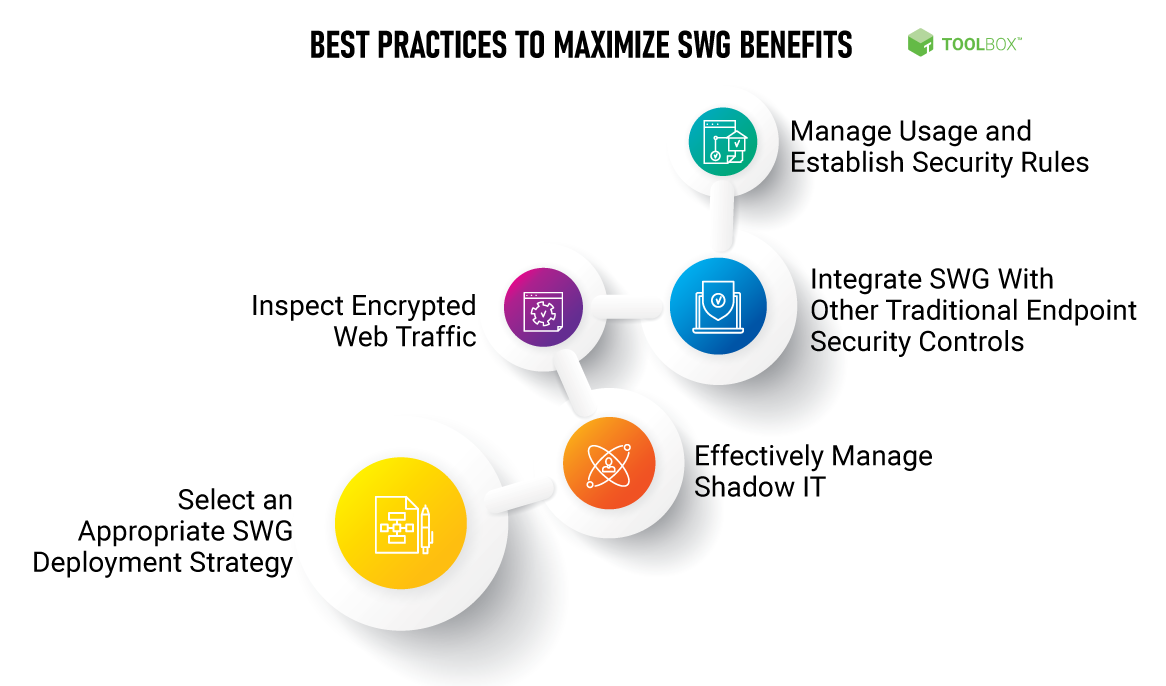BUSINESS
Reasons Why Your Company Needs a Secure Web Gateway Today

Key Takeaways:
- Comprehensive defense against sophisticated cyber threats is imperative for business continuity.
- Effective encryption management is crucial for the protection of sensitive data.
- Ensuring compliance with regulatory standards is essential to operate within the legal framework and maintain customer trust.
- Employee behavior and cybersecurity awareness significantly impact the organization’s overall security posture.
- Strategic investment in cybersecurity infrastructure is vital for future-proofing a company’s operations.
Table of Contents:
- Introduction
- Defense Against Advanced Cyber Threats
- Protection of Sensitive Data Through Encryption
- Managing and Monitoring Online Employee Behavior
- Ensuring Compliance with Regulatory Standards
- Creating a Culture of Cybersecurity Awareness
- Future-Proofing with Tech Investment
- Conclusion
Introduction
The intersection of business and technology brings about dynamic transformations as well as demanding challenges, especially in the realm of cybersecurity. The digital arms race against cybercriminals intensifies at this juncture, requiring companies to fortify their protocols and infrastructure to safeguard their assets. An indispensable tool for achieving this security is the secure web gateway (SWG), which acts as a vigilant sentinel guarding the gateway to a company’s digital ecosystem. We will dive into five compelling reasons why deploying an SWG is not just advisable but essential for businesses in today’s digital environment.
Defense Against Advanced Cyber Threats
Cybersecurity confronts a sprawling array of continuously evolving threats, rendering traditional defense mechanisms inadequate. Advanced cyber threats include stealthy zero-day attacks, sophisticated ransomware, and persistent APTs (Advanced Persistent Threats), which can cause catastrophic data breaches and system paralysis. An SWG sits at the forefront of a company’s cybersecurity defenses, comprehensively analyzing traffic, invoking advanced filtering techniques, and utilizing the latest threat intelligence to block malicious content and activities. Not only does it vet accessibility requests, but it also ensures that every packet leaving the company’s network is devoid of sensitive data or malware, maintaining integrity and confidentiality.
Real-Time Protection and Response
The immediate response capabilities of an SWG are critical given the fast-paced nature of cyber threats. By deploying real-time security measures, an SWG can halt an attack in its tracks, preventing potential damage or data loss. This capability ensures that an organization is not just recording incidents for post-mortem analysis but actively preventing them from manifesting into greater risks.
Protection of Sensitive Data Through Encryption
Data encryption is a fundamental security standard for preserving the privacy and integrity of sensitive data. It is a primary defense against unauthorized access during data transmission. A secure web gateway augments this by effectively managing encryption and employing robust algorithms to inspect encrypted traffic that could be concealing threats. It also allows organizations to enforce end-to-end encryption policies effectively, ensuring data remains secure throughout its lifecycle. Furthermore, these capabilities integrate seamlessly with rights management and access control systems, adding another layer of security to sensitive information.
Encryption as a Double-Edged Sword
While encryption is an essential tool for data protection, adversaries can exploit it to mask illicit activities. A sophisticated SWG can inspect encrypted communications without compromising user privacy, uncovering and mitigating hidden threats under legitimate encryption. This nuanced management of encryption is instrumental in adapting to the continuously evolving privacy landscape.
Managing and Monitoring Online Employee Behavior
The emergence of remote work has expanded the perimeter that companies must secure, intensifying the need to monitor employee online behavior. SWGs excel in this domain, offering comprehensive control over web access and facilitating policy adherence even in decentralized work environments. They enable IT administrators to react swiftly to any anomalous activity that may indicate a security breach or policy violation, ensuring that the digital workplace remains a secure zone for corporate activities.
Enhanced Visibility for Proactive Measures
The extensive reporting tools an SWG provides give organizations the visibility needed to make informed decisions regarding their cybersecurity posture. These tools shed light on usage patterns, inform resource allocation, and direct proactive measures to strengthen security where it’s most needed.
Ensuring Compliance with Regulatory Standards
The regulatory landscape concerning data security and privacy is elaborate and ever-changing. Adherence to these regulatory frameworks—such as the GDPR’s stringent data protection requirements—is non-negotiable for businesses to avoid severe repercussions. Secure web gateways facilitate this compliance by providing mechanisms to control and audit traffic, detect data exfiltration attempts, and manage consent protocols, which are vital functions to stay within regulatory boundaries.
Mitigating Compliance Risks
In addition to setting up defenses against external threats, a secure web gateway protects against inadvertent compliance breaches from within an organization. Through detailed logging and vigilant traffic monitoring, SWGs help pinpoint and rectify compliance missteps, avoiding costly penalties and preserving the organization’s reputation.
Creating a Culture of Cybersecurity Awareness
While technological solutions form the backbone of cybersecurity, the human element is a potential weakness and a powerful line of defense. Empowering employees through continuous education and layered security awareness training transforms them into informed guardians of the organization’s digital assets. SWGs support this culture change by integrating educational tools and alerts that can reinforce training and strengthen a company’s cybersecurity framework.
Empowerment Through Awareness
By fostering an environment where security is everyone’s responsibility, organizations can significantly reduce the likelihood of internal threats while building resilience against external attacks. This people-centric strategy bolsters the technical capabilities of security systems like SWGs, showing the interdependent nature of technology and education in cybersecurity.
Future-Proofing with Tech Investment
Investing in a secure web gateway is an investment in the company’s future. In an era where technology is rapidly advancing, and cyber threats are growing in complexity, an SWG is an essential technology that provides adaptive security measures. Businesses prioritizing the integration of cutting-edge security solutions will protect their current operations and future-proof their infrastructure against evolving threats. An SWG demonstrates a commitment to robust security standards and an understanding of the critical importance of a solid cybersecurity infrastructure.
Adaptive Security and Technological Evolution
As security threats evolve, so must the countermeasures that protect against them. A secure web gateway allows an organization to adapt its defensive posture as needed. With modularity and scalability, SWGs enable businesses to upgrade their security capabilities in alignment with the emerging technological landscape and evolving adversary tactics.
Conclusion
In the battle against cybercrime, a secure web gateway is an invaluable ally for any enterprise. By offering advanced protection against external and internal threats, ensuring compliance with intricate data protection laws, and fostering an educated workforce, SWGs are not just a technological necessity but a strategic enabler. They allow companies to navigate the treacherous waters of cybersecurity with confidence. An SWG is not only an immediate shield but also a long-term investment that underpins a company’s commitment to security, setting the stage for sustainable growth and digital resilience in a landscape fraught with cyber risk.
BUSINESS
Maintaining Peak Performance in Your Refrigerator: The Role of Ice Makers

Key Takeaways:
- Delving into the intricate workings of fridge ice makers.
- Providing comprehensive maintenance tips for consistent ice production and quality.
- Detecting potential issues that could lead to ice maker repair or replacement.
- Choosing an eco-friendly ice maker aligned with modern environmental standards.
- Benefiting from available informative resources on refrigerator maintenance and repair.
Introduction to Fridge Ice Makers
The refrigerator is essential in any contemporary kitchen, providing convenience and efficiency to culinary enthusiasts. The integrated ice maker is an exceptional feature that stands out for its ability to dispense chilled beverages instantly. This splendid facility eliminates the need for manual labor and the hassle of filling and emptying ice trays, making it an attractive addition to any home. To fully take advantage of the benefits of this marvelous feature and prolong its lifespan, users must gain a comprehensive understanding of its mechanics and maintain it with diligence. Users can have a constant supply of ice with this remarkable appliance.
How Do Ice Makers Work?
The process of how a refrigerator’s built-in ice maker, like the one found on PartSelect.com, works is genuinely fascinating. Even though it may seem like it operates quietly in the background, the process it goes through to produce ice is dynamic and precise. First, an electrically-controlled valve opens, allowing household water to flow into the ice mold. Then, a built-in thermostat determines when the ice is suitably frozen. At this point, heating coils briefly warm the molds to loosen the ice, ensuring that the cubes can be easily dispensed. Finally, a motor thrusts the ice cubes into a collection bin, where they are ready to be used at any time. This process is automatic and repeats cyclically, ensuring a continuous supply of ice for your convenience. It is important to note that the quality of the components used in the process is crucial in determining the reliability of the ice maker.
Regular Maintenance for Ice Makers
Regular maintenance is crucial to ensure an ice maker’s optimal performance and extended lifespan. Taking simple, proactive measures that can have a profound impact is essential. Homeowners should clean the ice bin with warm water and mild detergent periodically to remove old ice residues and eliminate germs that may affect ice quality or cause health risks. If the ice maker has a water filter, it’s advisable to replace it at the intervals recommended by the refrigerator manufacturer. Doing so will help ensure fresher-tasting ice and prevent potential clogging of water lines. Regular inspections of the water inlet valve and line can help identify leakage issues that can lead to water damage and affect ice quality. Homeowners can take preventive measures to reduce breakdowns and ensure clear ice cubes.
When It’s Time for a Repair or Replacement
Ice makers are incredible appliances designed to provide an endless supply of ice, but even with diligent maintenance, they are not immune to wear and decay. Suppose you notice a decline in ice production, water leakage, or strange sounds during operation. These signs indicate that the ice maker might require professional servicing or a complete replacement. Discolored ice cubes could suggest the presence of mineral deposits in the water line or rust inside the system, and these issues require immediate attention to prevent further damage. By recognizing these signs early, appliance owners can take swift action, potentially warding off costlier repairs or full-system failures. It is essential to stay alert and care for your ice maker to ensure it operates efficiently and effectively.
Ease of Troubleshooting Common Ice Maker Issues
A proactive approach often resolves many ice maker issues without expert intervention. Some common problems, such as stalling of ice production, can be tackled with straightforward measures like checking for a blockage in the fill tube or ensuring strong water flow for the ice maker’s operation. Detectable frost or icy buildup usually signals a damaged seal or gasket, which can permit outside air to infiltrate and cause unwanted frost—a simple gasket replacement could be the quick fix. Unpleasant tasting or smelly ice often necessitates cleaning the ice bin or changing the water filter to rid the system of the cause of odor or contamination. Such basic troubleshooting techniques can usually save homeowners both time and expenses.
Selecting a Replacement Ice Maker
If your refrigerator’s ice maker reaches the end of its functional lifespan or suffers irreparable damage, selecting the correct replacement is critical. The market offers a diverse range of ice maker models that can be fitted to various refrigerators. Opting for a compatible unit ensures smooth operation and decreases the likelihood of future malfunctions. In such scenarios, the appliance’s model number is your trusty reference, guiding you to the precise part that will complement your refrigerator seamlessly.
Environmental Impact of Ice Makers
As people become increasingly aware of environmental concerns, they are paying more attention to household appliances’ impact on the planet. Refrigerators, in particular, are being scrutinized for their high energy consumption and ecological footprint. This has led to a growing concern about ice makers, which are essential to refrigerators and contribute significantly to their energy usage. As a result, consumers are seeking more eco-friendly options for their refrigeration needs. It’s worth noting that modern ice makers are increasingly designed to be more energy-efficient and are often incorporated into energy-saving refrigeration solutions. By referring to resources such as the Energy Star Criteria for Refrigerators, environmentally conscious individuals can make informed and sustainable choices when selecting eco-friendly appliances.
BUSINESS
Data Detectives: How Your Participation in Clinical Trials Advances Medical Science
Key Takeaways:
- Understanding the integral role of clinical trials in medical progress.
- Recognizing the benefits and risks of clinical trials to participants.
- The ethical considerations and the importance of informed consent.
- How data from trials can shape the future of healthcare.
Table of Contents:
- The Foundations of Clinical Trials
- Volunteer Engagement: The Heart of Discovery
- Demystifying the Clinical Trial Process
- The Significance of Informed Consent
- Efficiency and Ethics: The Dual Priorities
- Behind the Scenes: Data Analysis in Trials
- Impact on Future Medicine
- How to Become a Clinical Trial Volunteer
The Foundations of Clinical Research
Clinical research is the critical cornerstone of medical advancements, reflecting the symbiosis between scientific rigor and human volunteerism. These protocols are essential for ascertaining emerging medical interventions’ safety and efficacy and ensuring continued treatment options development. The grounding principle of any clinical trial is the structured framework that guides its processes. This framework is methodically designed and subject to intense scrutiny by regulatory bodies, ensuring that new therapies are effective and safe for the populace. The structured nature of clinical research allows professionals to take logical and measured steps toward breakthroughs in medical science.
Volunteer Engagement: The Heart of Discovery
At the fulcrum of all clinical research efforts are the trial participants themselves. These individuals, often called volunteers, play an invaluable role in discovering new treatments. By agreeing to partake in trials, they provide a service that transcends personal benefit. They contribute to a broader societal good, encompassing enhanced knowledge about disease processes, potential treatments, and therapeutic interventions. Acknowledging the benefits and risks of clinical trials is pivotal to participant involvement. Volunteers are thoroughly briefed on possible side effects, anticipated outcomes, and the crucial nature of their contribution, thus enabling them to make informed decisions and be active, informed contributors to the trial process.
Demystifying the Clinical Trial Process
Many people may find the clinical trial process opaque and complex, fraught with scientific jargon and intricate procedures. Breaking down these barriers to understanding is crucial for enhancing public engagement and transparency. It is typically segmented into a series of phases, each meticulously design to serve a particular purpose. Phase I trials act as a safety check for a new intervention on a limited number of participants, while Phase II studies involve a larger group to evaluate its effectiveness. After completing these stages, Phase III trials are conducted on a larger scale, comparing the intervention with existing treatments to establish superiority or equivalence.
The Significance of Informed Consent
Informed consent is a crucial pillar of clinical research, acting as a gateway for participant autonomy and safety. This process involves educating potential participants about the clinical trial understandably and comprehensively. The informed consent form details every aspect of the trial, such as the nature and purpose of the research, anticipated risks and benefits, alternative procedures or treatments, and the participant’s rights, including the right to withdraw from the trial at any time. This transparency protects the volunteer and fosters an environment of trust and ethical practice within the trial. Allowing participants to enter the study with a complete understanding of their involvement is a moral obligation and cornerstone of compassionate research practices.
Efficiency and Ethics: The Dual Priorities
Clinical research operates on two inextricably linked priorities: efficiency in data collection and unwavering commitment to ethics. Researchers seek to obtain robust and high-quality data that can withstand scrutiny and form the basis for medical guidelines and treatment protocols. Simultaneously, the ethical considerations in clinical trials encompass participant privacy, informed consent, risk minimization, and the equitable selection of research subjects. These measures ensure that pursuing scientific knowledge does not compromise human dignity and respect for individual rights.
Behind the Scenes: Data Analysis in Trials
The success of clinical research is inherently tied to the meticulous analysis of the data it generates. Teams of statisticians and data scientists work in the background, sifting through vast amounts of information to identify trends, outcomes, and potential issues. The data analysis phase is meticulous and delicate, as it holds the key to validating the effectiveness of new medical interventions. During this phase, the results are interpreted to derive conclusions that could impact the availability of new treatments to patients worldwide.
Impact on Future Medicine
Clinical research is significant because it opens the possibility of new treatments and lays the groundwork for future innovations. Successful clinical trials have far-reaching implications; they inform clinical guidelines, contribute to scientific literature, and can significantly alter the course of patient care. In this sense, the data obtained from clinical trials is a valuable asset that can influence healthcare policy, funding allocations, and the standard of care delivered to patients globally for generations to come.
How to Become a Clinical Trial Volunteer
For those considering altruistic involvement in clinical trials, the path begins with understanding the eligibility criteria for participation and the depth of the commitment needed. Prospective volunteers should gather information on available trials that match their interests or conditions. The next step usually involves a pre-screening or an initial discussion with the trial coordinators, who provide detailed information on the trial’s scope and expectations. Making an informed decision to volunteer is not just a personal choice but a potential contribution to the collective medical advances.
For more information on the ethical and procedural nuances of clinical trials, interested individuals can consult global health authorities that offer resources and fact sheets for public education.
It’s critical to keep up with the most recent advancements in clinical research. News outlets often provide insightful coverage of current clinical trials and the strides in medical science, which can serve as a rich resource for learning about ongoing advancements.
BUSINESS
Winning in the Digital Aisle: Cutting-Edge Strategies for Grocery Success

Traditional grocery business models are being disrupted due to an extensive digital transformation, demanding a strategic re-think of retail practices. Companies need to stay relevant by adopting innovative strategies and embracing technological advancements. Within this evolutionary phase, loyalty programs have transcended their conventional role as dynamic tools for fostering customer fidelity and driving sophisticated marketing tactics. This article delves into practical and innovative methodologies that grocery businesses can capitalize on to flourish in today’s volatile market.
Table of Contents:
- Personalization in Grocery Shopping
- Enhanced Online Presence and E-commerce
- Supply Chain Optimization for Grocers
- Emerging Payment Systems in Grocery Retail
- Grocery Delivery Innovations
- Utilizing Big Data for Customer Insights
- Sustainability Practices in Modern Grocery Businesses
- Community Engagement and Support Strategies
- Conclusion
Personalization in Grocery Shopping
The importance of personalization in grocery shopping is rising as stores work to accommodate each customer’s unique requirements and preferences. With the integration of grocery loyalty programs, retailers can offer personalized discounts, recommendations, and incentives based on shopping habits and preferences. By analyzing data from loyalty programs, retailers can tailor promotions and offers to specific customers, enhancing their shopping experience and fostering loyalty. Customization boosts customer happiness and encourages recurring business by making them feel appreciated and understood. Personalization will become increasingly important in determining the future of grocery shopping as technology advances.
Enhanced Online Presence and E-commerce
Grocery companies must prioritize developing a solid online presence and making e-commerce infrastructure investments as more and more customers shop online for convenience and accessibility. This includes creating user-friendly mobile applications and websites that provide safe payment methods, easy navigation, and seamless browsing. Additionally, implementing click-and-collect or home delivery services enables customers to shop for groceries conveniently from their preferred devices. Grocery companies may reach a larger audience, adjust to changing consumer preferences, and profit from the expanding demand for online grocery shopping by embracing e-commerce.
Supply Chain Optimization for Grocers
Competent supply chain management is proving to be a cornerstone for ensuring the availability and freshness of products – attributes that drive a grocery store’s reputation and profitability. Advancements in real-time tracking, predictive analytics, and automated procurement systems have enabled grocers to control their inventories meticulously. As demand forecasting becomes more precise, grocery businesses can reduce overheads and avoid oversupply, thus championing sustainability and operational efficiency. Optimized supply chains are influential in maintaining product integrity and providing complete transparency from farm to fork, which is vital in securing consumer trust.
Emerging Payment Systems in Grocery Retail
Integrating innovative payment solutions within the grocery retail space underscores a commitment to convenience and customer satisfaction. The emergence of diverse payment solutions, such as mobile wallets and contactless card technologies, has set a new standard for transaction ease and speed. The rapid embrace of such payment mechanisms is a testament to the sector’s agility and focus on consumer-centric innovation. By simplifying payment processes, grocers enhance the shopping experience and drive efficiency in operational workflows – a dual advantage that can significantly improve the bottom line.
Grocery Delivery Innovations
The delivery service domain within grocery retail has witnessed transformative innovations driven by consumer demands for immediate and flexible service. Modern grocery delivery ventures encompass traditional home delivery and expedited services and subscription models that ensure a regular supply of household staples. Innovative logistics solutions are being explored, from crowd-sourced delivery networks to autonomous delivery bots and drones that promise to redefine convenience. These advancements optimize resource allocation and revolutionize the consumer’s perception of grocery fulfillment.
Utilizing Big Data for Customer Insights
A significant data era has sprouted unprecedented opportunities for grocery businesses to dial into deep customer insights. A strategic analysis of datasets encompassing sales figures, customer demographics, and purchasing behaviors leads to actionable intelligence that can guide everything from stock management to promotional ordeals. Grocery businesses that harness the power of big data analytics set themselves up for a future where retail strategies are data-driven and customer-centric, thus vastly outperforming competitors still reliant on traditional intuition-based practices. This data-oriented approach provides a bird’s eye view of the grocery market, allowing retailers to anticipate future trends and react swiftly.
Sustainability Practices in Modern Grocery Businesses
Sustainability has surfaced as a principal factor influencing consumer choices, and grocery stores increasingly embrace sustainable business practices. Initiatives around reducing carbon footprints, minimizing waste, and fostering local ecosystems exemplify a commitment to environmental stewardship. Retailers are positioned as champions of green initiatives by providing reusable packaging, energy-efficient store designs, and an emphasis on lowering the carbon emissions connected with logistics. Such practices resonate with consumer values and secure long-term resilience by aligning with global sustainability objectives.
Community Engagement and Support Strategies
Strengthening community ties through active engagement and support is an essential strategic pillar for grocery stores aspiring to become local staples. Through community-centric programs, neighborhood collaborations, and partnerships, grocery businesses underscore their role as critical contributors to local welfare. Supporting farmers’ markets, localizing supply chains, and participating in community events authentically demonstrates the grocery sector’s commitment to the societal fabric. These actions engender goodwill and a shared sense of purpose, fostering robust bonds with the communities they serve.
Conclusion
As the article unearths the pivotal role of digital transformation in shaping the grocery retail sector’s trajectory, it is clear that technology and innovation walk hand-in-hand with enhanced customer satisfaction and sustainable business practices. Seamless integration of online platforms, personalized experiences, supply chain intelligence, novel payment options, big data analytics, delivery logistical advancements, environmental stewardship, and community involvement encapsulate the manifold strategies underpinning the thriving grocery industry. These initiatives commend grocery businesses for their adaptability and point towards a future where technology and personal touch blend to transform the way we perceive grocery shopping.
-

 LOVE MESSAGES5 months ago
LOVE MESSAGES5 months agoSweet Love Messages for Her to Make Her Smile
-

 LOVE MESSAGES5 months ago
LOVE MESSAGES5 months ago100 Romantic Good Evening Messages For Her & Him
-

 LOVE MESSAGES5 months ago
LOVE MESSAGES5 months agoRomantic Love Messages For My Husband With Images
-

 LOVE MESSAGES5 months ago
LOVE MESSAGES5 months ago50 Just Checking on You Text Messages for Him & Her
-

 LOVE MESSAGES5 months ago
LOVE MESSAGES5 months agoSweet Love Messages For My Wife With Images
-

 LOVE MESSAGES5 months ago
LOVE MESSAGES5 months agoLong Good Morning Messages to Make Her Fall in Love
-

 LOVE MESSAGES5 months ago
LOVE MESSAGES5 months ago50 Cute Good Night Sweet Dreams Messages For Lovers
-

 LOVE QUOTES3 months ago
LOVE QUOTES3 months agoplease forgive me quotes her him images







